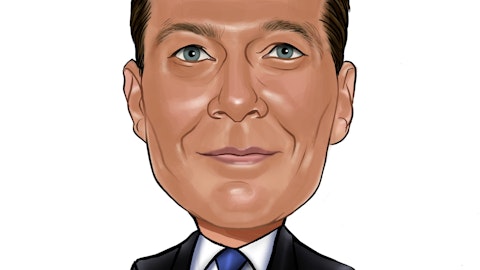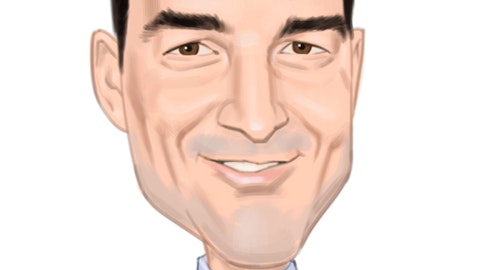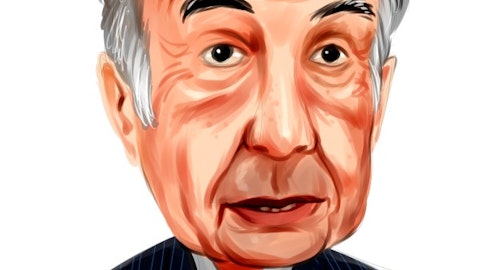Stephen Scherr: Sure. Yes, sure. So, first on the EV question, recognize that the total EV fleet is about 11% of the total fleet and Tesla’s represent about 80% of that. And so there’s quite a bit of the cost element that relates to the Tesla’s as opposed to others. Our focus and our work with Tesla is to look at the performance of the car so as to lower the risk of incidents of damage. And we’re in very direct engagement with them on parts procurement and labor and the like. So that’s working. I would say that overtime to the extent we take on more GM electric vehicles. As an example again, we’ll be buying all of the forward EVs at an appreciably lower price point than where we bought the 80% of our fleet, which is Tesla.
So that’s obviously of benefit. And I think that there are elements of those cars that will likely speak to lower incidence of damage, but I think perhaps more importantly, it will speak to a lower cost of parts and labor. Remember in the likes of GM and other OEMs, there’s decades of establishment of a broad national part supply network. There’s an aftermarket of parts that is there that is less mature, obviously, in the context of Tesla. And so I suspect, as implied by your question, that margins will improve and this issue will improve as we look to diversify. But that’s not to say that we don’t see improvement happening just on our own workflow, both to reduce incident and equally the way in which we incur the cost on this. So, I think there’s a natural progression of cost reduction.
But I think there’s work in front of us. We understand what it is, and we’re doing it to fix it. On the second part of your question around pricing, look, we’re dramatically changing the way in which Hertz as a brand behaves. I mean, for many, many years, Hertz was known as a brand that sort of played to the low end of price, meaning we played higher to volume, drove price down to find that volume and produce revenue on that basis. It is undeniably the inverse now. We have taken brands and disassembled them. We look at markets. We look at cars. We look at customer sets, and we broke down, for example, Hertz into deciles. We clipped the lower decile. Not willing to sort of rent at that particular price. And then we looked to find markets.
As I said in my prepared remarks that demonstrate price inelasticity. And as I said, I think it was at the JPMorgan Conference quite publicly in the summer. We were, at that point, orchestrating a price increase on Hertz. And we were able to do that in a way where we saw very little in the way of degradation of volume, but bringing price up. And remember, price runs about 80% to the EBITDA line. So you’re more than willing to sort of sacrifice volume where you can take price up not to the extreme, but within the boundaries of reason. And we did that. And we did see some followership, and we continue to show price leadership in and throughout markets where we can make that trade, and we will make that trade all day. The circumstance in dollar, as I mentioned, is a different one.
We’re reinvigorating that brand, and we’re doing that for a reason. We’re doing it because a better product will give us greater pricing leverage. And our hope and expectation is that we’re on a journey to get to better pricing parity to our competitors and we will get there. These are people that rent once or twice in an 18-month period. They are skewed heavily toward price, but not if the experience is going to be at a meaningful discount. And so bringing that experience up will give us pricing pressure. And again, as I said, the whole notion around dollar doesn’t depend on share and gaining days. It depends on taking a static number of days and bringing price up. And we’re quite confident in our ability to do that.
Ian Zaffino: Okay, thanks. If I could just squeeze in one quick one for Alex. Can you maybe just talk about some of the productivity initiatives you guys have in place now and kind of what are the benefits you’ve attained so far? Thanks.
Alexandra Brooks: Ian, thanks for the question. When you look at DOE per transaction day, the headwinds on collision and damages are masking the underlying progress we’ve been making on our core cost initiatives. And as we mentioned in our prepared remarks, we’ve achieved over $100 million of DOE savings on a year-over-year basis through these productivity improvements. About half of that is related to labor productivity, particularly in the field, and about half is in our fleet related cost savings like maintenance, fuel, and transportation costs. So double clicking into that, on field labor productivity, we reduced our own staffing overtime, and we’ve also cut back on our third-party labor. And on the theme of third party labor, we’ve also reduced it as it relates to our maintenance and vehicle documentation.
So by bringing more of this work in house, we’re better able to control our own costs and achieve our productivity objectives. On fuel, we’re using enhanced telematics to improve our accuracy. And on transportation costs, we’ve employed advanced fleet management tools to streamline our fleet movements and reduce our transportation costs. So we’re encouraged by our progress so far. But there’s more work to do here, as Stephen mentioned, and we’re looking forward to Justin Keppe joining the team as our new COO and driving these initiatives even further.
Ian Zaffino: All right, perfect. Thanks for the color. I appreciate this guys.
Alexandra Brooks: Thank you.
Operator: One moment for our next question. Our next question comes from John Healy with Northcoast Research. Your line is open. John, please make sure your line is unmuted. One moment for our next question. Our next question comes from Stephanie Moore with Jefferies. Your line is open.
Hans Hoffman: Hi, this is Hans Hoffman on for Stephanie. I was just curious, did moving more Teslas into your leisure segment, give you any sort of RPD bump in the quarter? And if so, could you maybe quantify that? And then I was also just kind of curious, I guess, do you think that over time that Tesla’s can kind of maintain their RPD premium, kind of given these sort of discounts or if there’s maybe some sort of novelty factor that’s kind of playing into the RPV premium there?
Stephen Scherr: Sure, thanks for the question. So, on the electric vehicles in leisure, I think on the forward, our view is that we need to bring supply in line with natural demand that’s being expressed. And as we’ve always said, we want to bring our fleet inside the demand curve. That same holds true in terms of electric vehicles in leisure. And there are a number of sort of parts to the demand equation on the rack side. Leisure, of course, being one where people have a natural desire and interest in driving an EV. Equally, our fleet becomes a very interesting proposition around test drive for a lot of these cars, for people who are being introduced to this. But equally, we see opportunity for EV deployment in rack, around insurance replacement, around corporate and government, all under the Hertz brand.
And in those cases, these are Tesla drivers who have an insurance replacement and will want to take on another EV as part of that insurance replacement product. And we see growth in corporate and in government where in both instances there’s a desire to pick up on sustainability objectives that they have. And so there are a number of pockets of demand that will drive in the rack side and we need to maintain the supply that’s inside that to attain kind of premium RPU, I would say equally and maybe more impactfully, the electric vehicle in our Rideshare business has an interesting and different and very strong level of demand. Again, that demand is on the part of the driver who wants entry into an electric vehicle, because the net economics to that driver, both by virtue of renting a car from Hertz around fuel and around incentives that are given to them by the rideshare or mobility companies, yields a better economic outcome from them or for them.
And to the extent that these cars are still expensive new and there’s been no real used market that come about, we become the natural and most economic entry point for those drivers to come in, and the benefit is proving out. And so we’re seeing meaningful growth in demand in the rideshare side and we’re equally seeing longer length of keep. And we’ve been designing incentives and programs and pricing schemes in tandem with Uber to sort of feed that, that is get more experienced drivers in with a longer length of keep. That obviously drives down damage cost, but equally it drives down cost overall because remember, length of keep in that business is key to bringing the ultimate cost down and the margin of that rental high.
Hans Hoffman: Got it. That’s helpful.
Stephen Scherr: Sure.
Hans Hoffman: And then I guess I just kind of wanted to touch on capital allocation decisions a bit. I think you guys have close to a billion sort of left in your buyback authorization. Just curious how you guys were thinking about buyback in Q4 and then into 2024 as well. Just kind of curious if higher fleet funding costs and then potentially lower residuals could be somewhat of like a limiting factor here.




